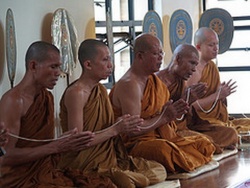Difference between revisions of "Steps to Conducting a Puja"
m (Text replacement - "sugar" to "sugar") |
|||
| Line 13: | Line 13: | ||
· Achamania – [[water]] is then [[offered]] for washing the face and {{Wiki|mouth}} of the [[deity]]. | · Achamania – [[water]] is then [[offered]] for washing the face and {{Wiki|mouth}} of the [[deity]]. | ||
| − | v Madhu-parka – a beverage made of [[honey]], | + | v Madhu-parka – a beverage made of [[honey]], sugar, and milk is [[offered]] to the [[deity]]. |
· Snanajala – the [[deity]] is [[offered]] [[water]] for bathing. | · Snanajala – the [[deity]] is [[offered]] [[water]] for bathing. | ||
| Line 33: | Line 33: | ||
· [[Dipa]] – the [[lamp]] is lit. | · [[Dipa]] – the [[lamp]] is lit. | ||
| − | · [[Naivedya]] – {{Wiki|rice}}, fruit, butter and | + | · [[Naivedya]] – {{Wiki|rice}}, fruit, butter and sugar are [[offered]] next. |
· [[Visarjana]] – the [[deity]] is finally bidden farewell. | · [[Visarjana]] – the [[deity]] is finally bidden farewell. | ||
Latest revision as of 06:06, 4 February 2016
There are three kinds of pujas:
A great puja is usually a community affair or performed during important occasions like religious festivals. This puja is comprised of all the steps below. An intermediate puja includes the steps from madhu-parka to naivedya and is performed during fasts or birthdays of deities. A small puja involves the steps from gandha to naivedya and is performed everyday. All pujas end with arativ Avahana – the invocation of the deity. Asana – a seat is offered to the deity.
· Svagata – the deity is welcomed, asked Honour, worship, reverence.’ to anoint or smear with sandalwood paste or vermilion.
· Padya – the feet of the deity are washed with water.
· Arghya – a respectful offering of water is made to the god. This water is laced with sandalwood paste, vermilion and rice
· Achamania – water is then offered for washing the face and mouth of the deity.
v Madhu-parka – a beverage made of honey, sugar, and milk is offered to the deity.
· Snanajala – the deity is offered water for bathing.
· Bhushana
· Abharanasya – clothes jewels and ornaments are offered next.
v Gandha – sandalwood paste or any other fragrant object is offered.
· Akshata – grains of rice mixed with vermilion are offered.
· Pushpa offered.
· Pushpanjali – flowers are offered.
· Dhupa – incense is lit.
· Dipa – the lamp is lit.
· Naivedya – rice, fruit, butter and sugar are offered next.
· Visarjana – the deity is finally bidden farewell.
· At the end, arati is performed.The object of performing the puja in this manner is to treat the deity as one would a guest, with honour and respect. In temples, the deities are treated as kings.Though the steps of worship are the same for all deities, there is some difference in the puja of each. For instance, the kind of flowers offered is different for each deity.
Presently, a puja might also involve japa or meditation. A very important part of any puja is the applying of tilaka and the distribution of Prasad to devotees.
